- Home
- Basic embroidery stitches
- Couching Stitch
Couching stitch: the secret to a harmonious embroidery session (and a happy marriage!)
"Couching stitch, you're my hero!" A bold statement? Perhaps.
Picture this: One evening, as I sat embroidering next to my significant other, a grumble emerged about the noise. Yes, noise from embroidery, can you believe it?
The culprit was the loud pop and scraping sound my chunky yarn made as it passed through the tightly hooped fabric. Who would've guessed?
Suddenly, I found myself on a quest: to discover a quieter stitch that could also be gentle on my fabric and thread.
Couching stitch to the rescue!
This technique proved to be the perfect solution for my issue, allowing me to use the stunning fibers I had painstakingly picked out.
I simply laid them atop the fabric, securing them snugly with finer embroidery threads.
The cherry on top? A process devoid of noise or friction.
No hassle, no difficulties, all thanks to the couching stitch which helped me incorporate those beautiful fibers into my project seamlessly.
Fibers you can couch down
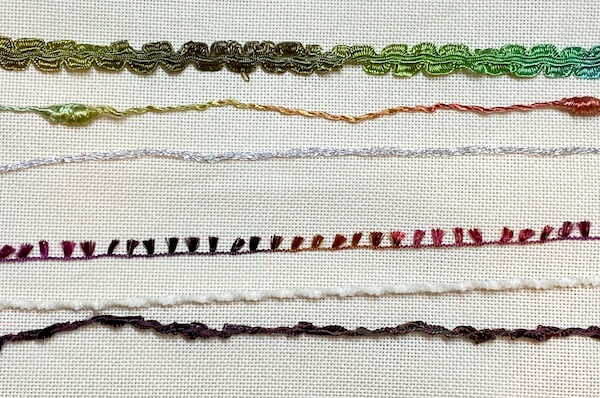
Couching stitch, oh the joyous variety it brings! This technique flings open the door to a world of fibers that can be snuggled down onto your fabric. And no, we're not just talking about traditional embroidery threads.
We're venturing into a world where your projects can sparkle with some serious pizzazz!
Cords. These thick, rope-like threads can add depth and dimension to your embroidery. Whether you want to create a bold outline or add a touch of texture to a design, couching cords can help you achieve the desired effect.
Braids are another type of fiber that you can couch down. These decorative trimmings come in a variety of colors and styles, allowing you to add a touch of elegance or playfulness to your embroidery. By couching them down, you can create intricate patterns or add a border to your design.
Fancy adding a dash of luxury to your embroidery? Consider faux fur! This soft, fluffy material, when couched down, can mimic a realistic fur effect, introducing a different texture to your design. This technique is not only a tactile delight but also a feast for the eyes, making your embroidery projects all the more appealing.
Arctic Rays, is also perfect for couching. These threads have a unique texture that adds a shimmery fringe effect to your embroidery. By couching them down, you can create beautiful highlights or add a touch of sparkle to your design.
If you're eager for a dash of playfulness in your work, try couching down boucle or bobbly yarns. These textured threads don't just add a fun element, they bring the funk to your embroidery. And it doesn't matter if you're crafting a masterpiece or just jazzing up a garment, these yarns will make your work pop like a cherry on a sundae.
Flat and tubular ribbons are also great fibers to couch down. They come in a variety of colors and widths, allowing you to create intricate designs or add a touch of elegance to your embroidery.
Imagine adding a touch of glamour to your embroidery with Chunky metallic threads. Picture them on a fancy evening gown or as a statement piece for your home decor.
Now think about how couching down these chunky metallic threads could instantly add a sparkle to your design. Consider the shimmer and shine, how they catch the light, and how they could make your embroidery pop.
Metallic threads? Sure, they're a great start. But let's not limit ourselves, shall we? Imagine infusing some beaded or sequinned threads into the mix. Beaded or sequinned threads add texture and dimension to your embroidery.
Visualize a floral design coming alive with delicate seed beads outlining the petals, or a starry night sky twinkling with sequins. The creative combinations you could come up with can be truly mesmerizing.
Are you in search of an extra festive touch? Look no further than Estaz! With a tinsel-like appearance, this unique fiber is just the ticket for sprinkling a bit of Christmas magic on your projects. Imagine a holiday-themed wall hanging or a stunning table runner for your festive dinner, all brought to life with the extra holiday sparkle that only couching down Estaz can provide.
When your next couching stitch project comes around, dare to stray from the traditional path and play around with different fibers.
The Impact of Color Choices
A choice as simple as colour selection can really jazz up the visibility and appearance of your couching stitches.
Fancy making a statement with your stitches? Go for contrasting colour threads!
Picture this - a vibrant red cord dancing with a fine white embroidery floss. It's like a festive candy cane has waltzed its way into your design, bringing a playful and festive touch to the party.
If subtlety is your style, opt for a couching thread that harmonizes with your laid threads and the background fabric. This technique gives the illusion of the couched thread floating on your embroidery's surface. It's all about color harmony here.
Say, you're working with a neutral background fabric, with laid threads in shades of beige or cream. In this case, a light tan or ivory couching thread would be the perfect fit. The result? A seamless and delicate appearance, where the couching thread and the fabric appear as one.
Get Creative with Your Couching Experience!
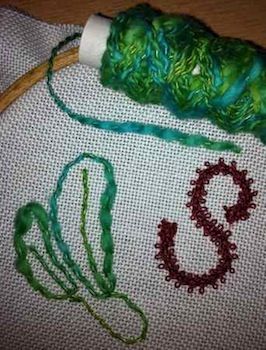 A couched braid and a yarn with thick and thin areas
A couched braid and a yarn with thick and thin areasWhen it comes to couching stitch, you are the artist!
Feel free to grab a disappearing ink pen and trace a doodle on your fabric to guide your stitches.
Or how about going rogue, laying the thread wherever your heart desires, free from any guidelines?
Picture your thread as a whimsical artist, dancing across the fabric in swirls, spirals, and gentle curves, or standing shoulder to shoulder in neat lines.
Fancy a layered look? Cross over previous lines to form a nifty chequered pattern. There's just so much you can do!
I created the letter S on the piece above from a burgundy braid sold for miniature doll's clothing, stitched in place with a matching strand of floss.
Couching stitch techniques
Couching stitches, in their simplest form, are diminutive straight stitches that secure a thicker thread. Coming up on one side and going down the other, the needle effectively locks the thread in place. A neat trick some people use is reusing the same hole to keep the stitches inconspicuous.
But hey, don't feel confined to uniformity! You can space these stitches evenly, scatter them randomly, or arrange them in patterns - your canvas, your rules!
For a fun twist, consider alternating the position of the stitches in each row. This can create a brickwork effect, much like the sample displayed in the photo.
Using a dark blue ribbon in my example, I folded it back like a hairpin at the end of each row. Next, light blue floss came in handy to stitch it down to the fabric. A simple technique indeed, but oh, does it add a nice touch!
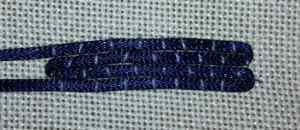 Couching in a brickwork formation
Couching in a brickwork formationJust a little heads up, couching stitches aren't exclusive to your everyday embroidery. They also make a star appearance in goldwork.
Imagine this: gold threads elegantly laid side by side on the fabric, held down by silk in a rather snazzy diaper pattern. I must say, it's quite a fancy affair.
Envision stitching a tiny bird's foot with a white soft cotton covered with floss. You're aiming to give that foot a touch of texture and dimension, to make it truly stand out.
To achieve this, you'll want to create a raised line, ensuring the thicker thread is entirely concealed by the couching stitches.
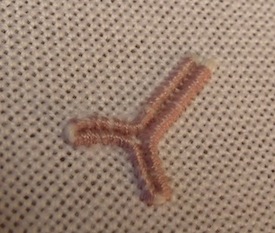 Raised cording resembling a bird foot
Raised cording resembling a bird footBy ensuring your couching stitches are close together, you hide the thicker thread neatly. The result? A smooth, raised line that gives your embroidery some dimension.
But hold your needles, we aren't done!
This technique, with its close-knit couching stitches, paves the way for a range of exciting new designs. Picture yourself stitching a vine that appears to pass in front of a tree trunk or branch. Oh, get ready, because your embroidery game is about to get a serious boost.
You've now dipped your toes into the world of stumpwork, an embroidery style that adds a three-dimensional twist to a flat surface. It's like adding a dash of magic and bringing your embroidery to life!
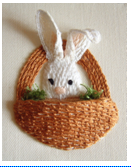
Let's talk about a technique that can be used in stumpwork - Bokhara couching.
It's like stitching and weaving at the same time, and boy, does it create a stunning effect!
With my bunny project, I experimented with this method. The goal? To create a snug basket for my little fluffy friend.
And you may ask, what's the magic behind Bokhara couching? It's quite simple: you lay down a long horizontal stitch and secure it with tiny stitches. Varying their position will give that woven appearance.
You wouldn't believe how this technique turned my bunny project around! It added such a realistic texture to the basket, making it look oh-so-inviting. It's truly amazing how a simple stitch can bring a flat piece of fabric to life!
Whether you're a seasoned stumpwork enthusiast or a newbie eager to add some texture to your stitching, this is a must-try.
Couching with embroidery stitches
Don't feel boxed in by a simple straight stitch when you're couching. Your project can be spruced up with a variety of embroidery stitches, lending it a dash of interest and creativity.
Take the Cretan stitch, cretan stitch, for example. As seen in the picture below, it creates a beautiful, undulating line used to attach a length of ribbon to a crazy quilt block. Not only does it secure the ribbon, but it also adds a delightful texture to the overall design.
Or, if you're feeling adventurous, the Herringbone stitch could be a great alternative. Its diagonal lines can weave a visually pleasing effect.
Don't think you're stuck with a simple straight stitch when it's couching time! Your project can dance with interest and creativity, all thanks to a variety of embroidery stitches.
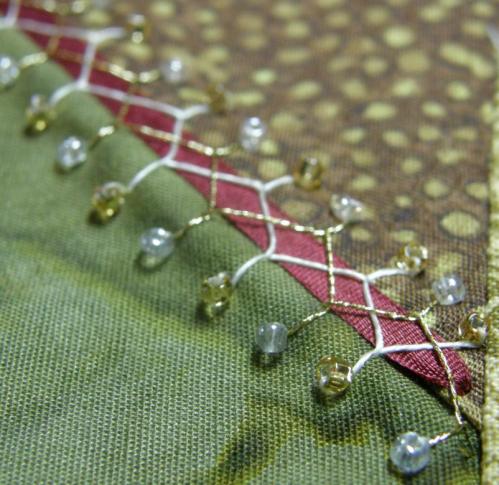
But why stop there?
Allow your imagination to roam free and dabble with various stitches. Take for instance, using a chain stitch down the middle of your ribbon to secure it. This stitch forms a sequence of loops, gracing your work with a playful and whimsical vibe.
There's no end to what you can create, and there's no rulebook to follow. Let your stitches, colors, and creativity mingle freely!
It's a delightful and inventive way to add a twist to your embroidery. So, dare to step away from the beaten path of couching with a traditional straight stitch and explore new territories. You never know, you might stumble upon a stitch that could be your creative fingerprint!
The couching stitch in needlelace
How about the intricate world of needlelace? Couching stitch is a key player here.
Take a thread, double it over and carefully align it with your design. But we can't just leave it dangling like an unfinished thought, can we? That's as dangerous as leaving a loose thread on your favorite sweater, it's just asking for trouble!
So what do we do? We secure that thread down with tiny stitches that take a journey through all the layers - the pattern, and a thrice-folded fabric pad. Voila! This is what we call laying a cordonnet.
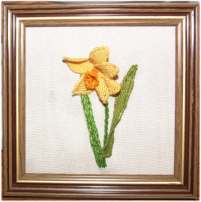
The couching stitches in your lace are just temporary. Once you're done with all the decorative stitching, you'll simply snip and remove them.
What you're left with is a lace that's free from the fabric base you worked on.
Intrigued? I've put together two tutorials for you. You can create a flat heart or a 3D daffodil - just head over to the needlepoint lace section of the website.
You can also read about the history of needlepoint lace.
Tips for couching success
Ready to begin your couching stitch adventure? Here are some handy tips to keep your journey glitch-free.
Securing the end
Begin by threading the braid or ribbon through from the back of your work, leaving a short tail to secure later on.
In case the fibre you're using is too thick, just position it where you want and secure with tiny stitches using a thread of a matching colour.
Should you wish to keep the end out of sight, consider camouflaging it with other embroidery or a button.
Consider durability
Best to reserve your couching stitch creations for those special occasions! This technique is much more suited for decorative pieces rather than practical items.
Why, you ask? Well, the long threads run the risk of snagging, and those pesky securing threads could break if handled too roughly.
Congratulations!
You've unlocked the secrets of couching stitch and are ready to start an exciting embroidery journey.
Remember, this technique not only adds texture and dimension to your projects but also allows you to make peace with your loved ones by eliminating noisy distractions.
So, go forth and explore the magical world of couching stitch, where beautiful threads come to life and creativity knows no bounds!
Happy stitching!
Stay connected between projects
If you’d like occasional updates from my embroidery room, including new patterns, gentle tips, and little things I think you might enjoy, you’re warmly invited to join the Stitchin’ Times newsletter.
No pressure. Just a friendly note now and then to keep you inspired.




